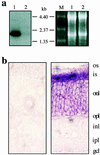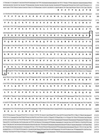A deletion in a photoreceptor-specific nuclear receptor mRNA causes retinal degeneration in the rd7 mouse
- PMID: 10805811
- PMCID: PMC25866
- DOI: 10.1073/pnas.97.10.5551
A deletion in a photoreceptor-specific nuclear receptor mRNA causes retinal degeneration in the rd7 mouse
Abstract
The rd7 mouse, an animal model for hereditary retinal degeneration, has some characteristics similar to human flecked retinal disorders. Here we report the identification of a deletion in a photoreceptor-specific nuclear receptor (mPNR) mRNA that is responsible for hereditary retinal dysplasia and degeneration in the rd7 mouse. mPNR was isolated from a pool of photoreceptor-specific cDNAs originally created by subtractive hybridization of mRNAs from normal and photoreceptorless rd mouse retinas. Localization of the gene corresponding to mPNR to mouse Chr 9 near the rd7 locus made it a candidate for the site of the rd7 mutation. Northern analysis of total RNA isolated from rd7 mouse retinas revealed no detectable signal after hybridization with the mPNR cDNA probe. However, with reverse transcription-PCR, we were able to amplify different fragments of mPNR from rd7 retinal RNA and to sequence them directly. We found a 380-nt deletion in the coding region of the rd7 mPNR message that creates a frame shift and produces a premature stop codon. This deletion accounts for more than 32% of the normal protein and eliminates a portion of the DNA-binding domain. In addition, it may result in the rapid degradation of the rd7 mPNR message by the nonsense-mediated decay pathway, preventing the synthesis of the corresponding protein. Our findings demonstrate that mPNR expression is critical for the normal development and function of the photoreceptor cells.
Figures






References
-
- Bowes C, Li T, Danciger M, Baxter L C, Applebury M L, Farber D B. Nature (London) 1990;347:677–680. - PubMed
-
- Noben-Trauth K, Naggert J K, North M A, Nishina P M. Nature (London) 1996;380:534–538. - PubMed
-
- McLaughlin M E, Sandberg M A, Berson E L, Dryja T P. Nat Genet. 1993;4:130–134. - PubMed
-
- Danciger M, Blaney J, Gao Y Q, Zhao D Y, Heckenlively J R, Jacobson S G, Farber D B. Genomics. 1995;30:1–7. - PubMed
-
- Bayes M, Giordano M, Balcells S, Grinberg D, Vilageliu L, Martinez I, Ayuso C, Benitez J, Ramos-Arroyo M A, Chivelet P, et al. Hum Mutat. 1995;5:228–234. - PubMed
Publication types
MeSH terms
Substances
Associated data
- Actions
Grants and funding
LinkOut - more resources
Full Text Sources
Other Literature Sources
Molecular Biology Databases
Research Materials
Miscellaneous

